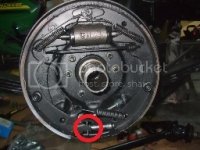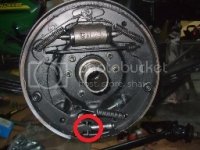Brakes 78 CJ7 - rear brakes approx 10% power
sewe
Jeeper
Hi,
my rear brakes do not really have huge function (11" drum brake). If I push my brake pedal almost complete down to the floor the rear brakes begin to work a little bit. On the brake test station this gets up to 10% of the normal function...but then the floor does not allow me to push further.
In the same time the front brakes seem to work o.k. (not the best brakes but really o.k.) (front is disc brake)
I changed the master cylinder (new replacement part)
I changed all hoses and tubes
I changed the proporting valve
so what is still old: the rear drum brakes and cylinders in there.
if I push the pedal more often in really short time it works good
if I press the parking brake a little bit until it is beginning to brake and then use the normal brake pedal all is good (perfekt)
so I tried all I could think of in the last month...but I can not find the real problem(reason)
- so the first question I have: which would be the correct brake cylinders for the 11" drum brake (name, part number, diameters)...I am not sure if there are the correct parts mounted inside
- is this problem known in some way? any ideas?
what kind of information do I need to post here or update so that someone could help better?
CJ7
'78
front brakes: disc (6 holes)
rear brakes 11" drum brake
brake booster looks bigger than the original one...seems not to be the original one
brake main cylinder: replacement-spare part...but from here on all looks original
left and right brake are almost similar (bad) funktion (no real differences)
thank you very much!!
sewe
my rear brakes do not really have huge function (11" drum brake). If I push my brake pedal almost complete down to the floor the rear brakes begin to work a little bit. On the brake test station this gets up to 10% of the normal function...but then the floor does not allow me to push further.
In the same time the front brakes seem to work o.k. (not the best brakes but really o.k.) (front is disc brake)
I changed the master cylinder (new replacement part)
I changed all hoses and tubes
I changed the proporting valve
so what is still old: the rear drum brakes and cylinders in there.
if I push the pedal more often in really short time it works good
if I press the parking brake a little bit until it is beginning to brake and then use the normal brake pedal all is good (perfekt)
so I tried all I could think of in the last month...but I can not find the real problem(reason)
- so the first question I have: which would be the correct brake cylinders for the 11" drum brake (name, part number, diameters)...I am not sure if there are the correct parts mounted inside
- is this problem known in some way? any ideas?
what kind of information do I need to post here or update so that someone could help better?
CJ7
'78
front brakes: disc (6 holes)
rear brakes 11" drum brake
brake booster looks bigger than the original one...seems not to be the original one
brake main cylinder: replacement-spare part...but from here on all looks original
left and right brake are almost similar (bad) funktion (no real differences)
thank you very much!!
sewe




